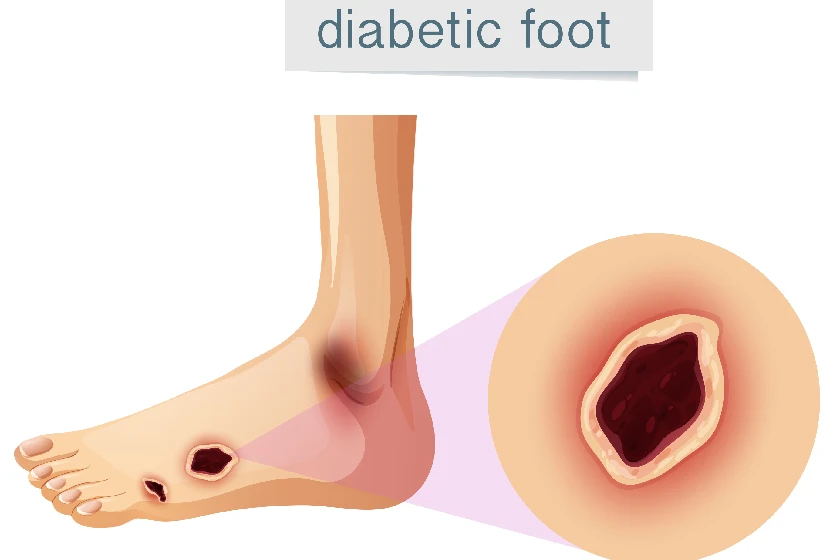
One of the most alarming conditions I see in my practice is a patient walking in with a wound on the leg that has refused to heal for weeks. At first, it may look like a small cut or patch of skin irritation. But slowly, it deepens, begins to ooze, and instead of improving, it worsens. Left untreated, such a wound can grow larger, become infected, and in severe cases, even threaten the limb itself. This is not just a skin issue—it is a venous leg ulcer.
Many people underestimate leg ulcers, hoping they will resolve on their own. Unfortunately, they rarely do. These ulcers are not only painful and disabling, but they are also a warning sign of poor vein circulation. Without timely treatment, a simple ulcer can spiral into serious complications, including severe infection and, in extreme cases, amputation.
The most common question patients ask me is: “Doctor, how do I know if my ulcer is healing or getting worse?” The answer lies in understanding the stages of leg ulcer healing. By recognizing these stages, patients can monitor their progress, seek help at the right time, and stay motivated through the often long healing journey.
What are Venous Leg Ulcers?
Venous leg ulcers are open sores that usually occur on the lower leg, often near the ankle. They are caused by long-term venous insufficiency, a condition in which the veins of the legs do not function properly. When blood fails to flow back to the heart efficiently, it pools in the legs, creating high venous pressure. Over time, this pressure damages the skin and underlying tissues, eventually breaking them down into ulcers.
Among all leg ulcer types, venous ulcers are the most common, accounting for about 70–80 percent of chronic wounds on the legs. They are stubborn, painful, and recurrent. Unlike small injuries, venous ulcers need medical attention and careful monitoring by venous ulcer specialists or a trained leg ulcer doctor.
What Does a Leg Ulcer Look Like?
At first glance, a venous leg ulcer may look like a small red patch, a rash, or a darkened area on the skin. Over time, the skin becomes dry, itchy, or hardened. When the ulcer opens, it appears as a shallow wound with irregular edges, surrounded by discolored skin.
The wound may ooze fluid, and if infected, it can release foul-smelling discharge. Patients often experience swelling, heaviness, and persistent pain in the leg. Unlike ordinary wounds, venous ulcers do not heal quickly because of the underlying circulation problem. This is why timely venous ulcer treatment is so important.
What Causes Venous Leg Ulcers?
The main cause of venous ulcers is chronic venous insufficiency. Normally, valves inside the leg veins ensure blood flows upward toward the heart. When these valves weaken or are damaged, blood flows backward and pools in the legs. This leads to venous hypertension, which gradually breaks down the skin and tissues.
Other common leg ulcer causes include:
- Varicose veins
- Previous history of deep vein thrombosis (DVT)
- Obesity and a sedentary lifestyle
- Trauma or injury to the leg
- Age-related vein weakness
- Family history of venous disease
Once ulcers form, they rarely heal without the guidance of a venous ulcer doctor.
Stages of Leg Ulcer Healing
Healing is not instant. It happens step by step, and every stage gives important clues about progress. By understanding these stages of leg ulcer healing, patients and caregivers can recognize warning signs, follow medical advice, and avoid worsening of the condition.
Early Skin Changes
Before the ulcer forms, the skin shows warning signals. Patients may notice dryness, itching, redness, or brownish discoloration around the ankle. At this stage, the skin is under stress from poor circulation. If ignored, the skin weakens further. This is the most crucial time to consult venous ulcer specialists, because preventive care can stop ulcers from appearing altogether.
Edema and Inflammation
As venous pressure increases, swelling (edema) sets in. The leg becomes heavy and uncomfortable, and the skin turns fragile. Inflammation makes the skin hot, tight, and prone to cracking. Once this stage develops, the risk of an open ulcer rises sharply. Compression therapy, leg elevation, and lifestyle changes play an important role here.
Skin and Tissue Damage
The skin starts breaking down. It may become shiny, hard, or leathery. Small cracks or scabs appear, and even a minor injury can create a wound. This is a pre-ulcer stage where immediate intervention from a leg ulcer doctor can still prevent further damage.
Active Ulcer
This is when the wound becomes visible. The ulcer appears as an open sore, usually shallow but irregular in shape, surrounded by darkened or hardened skin. Patients often report pain, swelling, and sometimes pus or foul discharge if infected. This is the most dangerous stage because infection can spread quickly if not treated.
During this stage, wound care with dressings, antibiotics when required, and strict compression therapy are essential. In more severe cases, advanced venous ulcer treatment or surgical procedures may be required to correct the underlying venous circulation.
Healing (Maturation)
If treatment is followed properly, new tissue starts to form inside the ulcer. The wound edges shrink, the discharge reduces, and healthy pink tissue replaces damaged areas. Eventually, the wound closes and skin covers the area.
This stage can take weeks or months, depending on the severity of the ulcer and the overall health of the patient. Even after healing, the skin remains fragile and prone to recurrence. Continued follow-up with a venous ulcer doctor is essential to maintain long-term recovery.
Conclusion
Leg ulcers are far more dangerous than they appear. What begins as a small skin change can, if ignored, grow into a painful, infected, and disabling condition that severely affects quality of life. In some cases, untreated ulcers can even lead to limb loss.
The good news is that with early diagnosis, proper care, and expert guidance from venous ulcer specialists, healing is absolutely possible. Recognizing the stages of leg ulcer healing helps patients track their progress and remain hopeful. But the most important step is to seek timely medical help.
As a vascular surgeon, I have seen patients regain their health and confidence with proper venous ulcer treatment. But I have also seen the devastating consequences when ulcers are neglected. If you or someone you know is struggling with a non-healing leg wound, consult a leg ulcer doctor without delay. The sooner you act, the better your chances of healing and preventing recurrence.
Frequently Asked Questions
A healing ulcer becomes smaller, less painful, and produces less discharge. The wound fills with healthy pink tissue, and the edges begin to contract.
The stages include early skin changes, swelling and inflammation, skin and tissue damage, an active ulcer, and finally the healing or maturation phase.
Ulcers heal in three broad phases: inflammation, tissue formation, and maturation. In venous ulcers, these phases take longer, but with treatment, they can be guided effectively.

Dr. Sumit Kapadia
MBBS, MS, MRCS, DNB-Fellow



